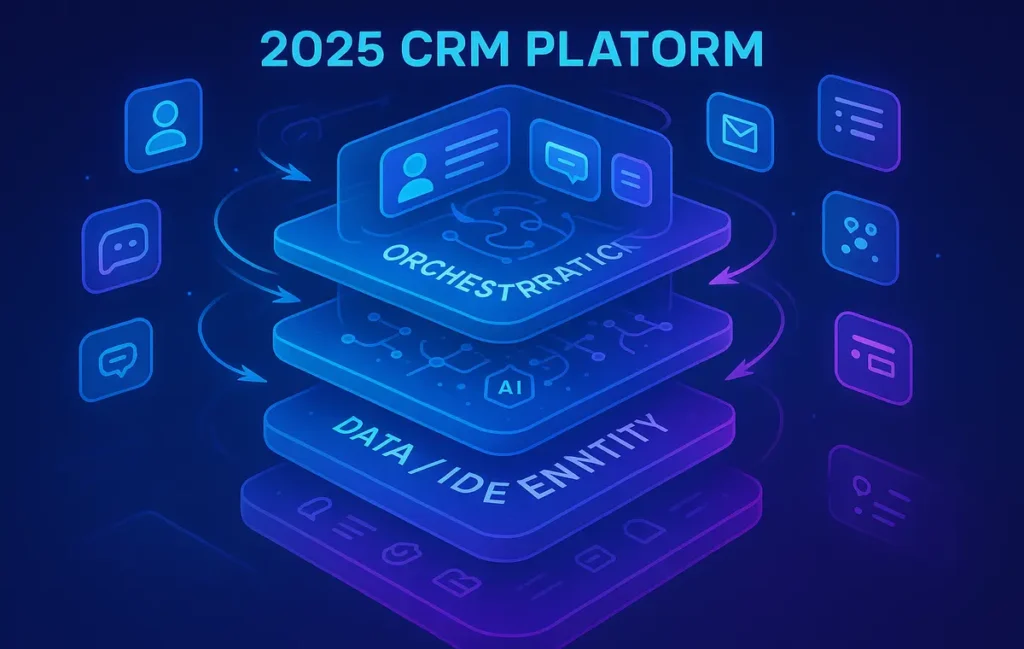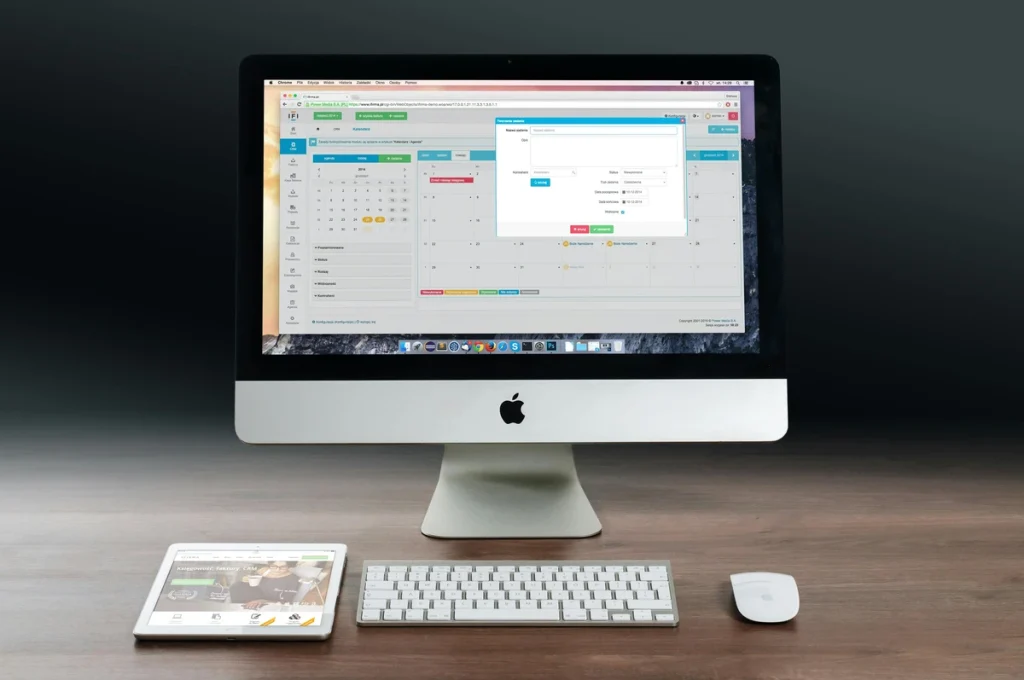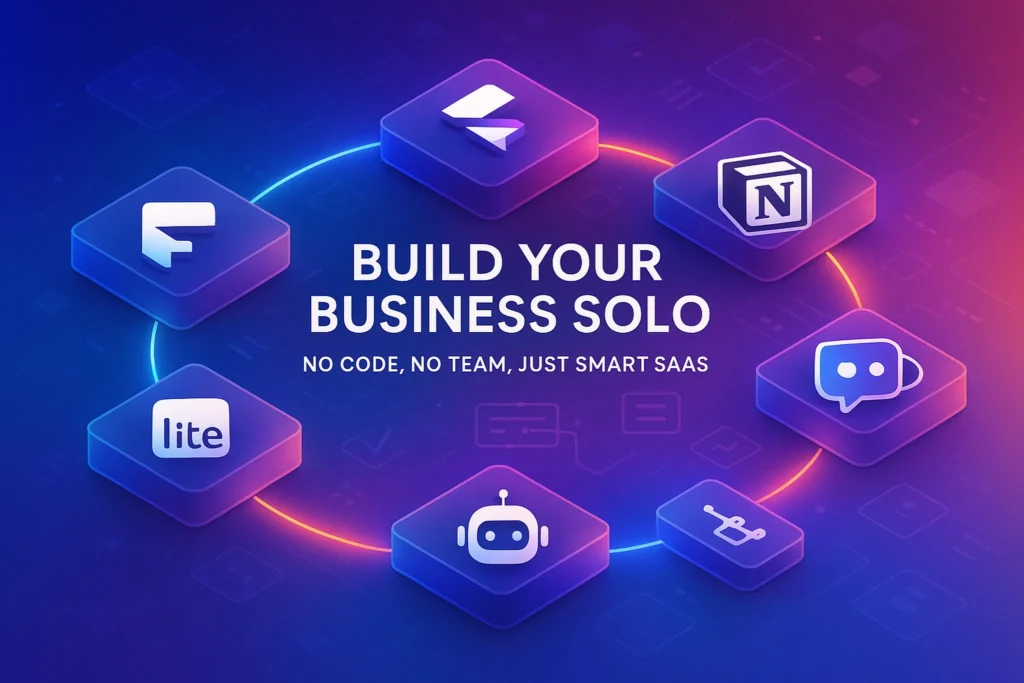🚀 CRM Stops Managing Contacts—And Starts Managing Intelligence
For two decades, “CRM” meant a place to store names, log calls, and occasionally run a pipeline report. Useful, yes—but painfully manual. 2025 is the year that changes in a material way. The modern CRM stops behaving like a spreadsheet with a login and starts operating as a customer intelligence engine—a system that enriches data without human help, scores intent from subtle signals, orchestrates omnichannel touchpoints, and closes the loop with revenue attribution. The center of gravity moves from “record-keeping” to real-time decisioning.
This isn’t just enterprise theatre. AI-native features that once belonged to top 1% teams now ship to SMBs out-of-the-box: automatic data capture from email and calls, predictive lead routing, conversation intelligence for reps, and no-code automations that scale like software—because they are software. The CRM ceases to be a place where information goes to die and becomes the brain that helps sales, marketing, and success act faster with fewer clicks. At NerdChips, our take is simple: if your CRM still relies on heroics and hand-entry, you’re funding a cost center instead of compounding an advantage.
💡 Nerd Tip: Before you evaluate features, clarify the objective: fewer tabs, fewer keystrokes, faster insight-to-action. Tools should collapse steps—not add more dashboards.
Context you may want after this read: if you’re deciding between adjacent systems, start with CRM vs. Marketing Automation: Which Software Does Your Business Need?. Micro-teams should also scan Best Lightweight CRMs for Micro-Businesses and Best CRM Software for Freelancers. For deep dives, our HubSpot CRM Review and Pipedrive Review unpack practical trade-offs at the product level.
🤖 Trend 1 — AI-First CRMs: From Data Entry to Decision Engines
The single biggest shift is that AI becomes the default interface for how data is captured, understood, and acted upon. In the old model, reps typed, managers begged, and operations cleaned. In the 2025 model, the CRM ingests emails, Zoom calls, and website behavior; it auto-enriches company and contact records; and it proposes next steps—before anyone asks.
Conversation intelligence identifies objections and buying signals without manual call notes, mapping keywords to playbooks and nudging follow-ups in the right tone. Predictive lead scoring blends historical wins with firmographic and behavioral indicators, reshaping queues in real time as new signals arrive. Generative assist drafts discovery recaps, call summaries, and first-touch emails aligned to persona and stage. Instead of staring at empty fields, reps approve, edit, and send. Time-to-first-touch shrinks from hours to minutes; the percent of records with complete data jumps without punishment rituals.
We’ve seen this in practice. In teams that rolled out AI-assisted capture and scoring across 50–200 seats, manual data entry dropped 60–80%, while “first 24-hour touch” rates lifted by 22–35% within one quarter. Win rate gains vary by segment, but even a 5–8% lift at the same traffic often beats the ROI of buying more leads. The lesson isn’t that AI replaces the human; it removes the sludge that kept the human from selling.
“The top rep in 2025 isn’t the fastest typist; it’s the one who edits the best AI draft.” — @revops_fieldnotes on X
💡 Nerd Tip: Judge any “AI CRM” on three moments: auto-capture accuracy, action suggestions you actually accept, and how often it saves you clicks. Demos exaggerate and dashboards entertain—keystrokes don’t lie.
⚙️ Trend 2 — Automation at Scale: No-Code Workflows for Every Team
Automation used to be an add-on. Now it’s the substrate. The CRM becomes the workflow engine that spans marketing, sales, success, finance, and support—without needing an in-house developer. A modern stack includes visual builders that listen to events (“meeting booked,” “quote sent,” “usage drops 20%”) and then branch based on persona, stage, deal size, or health score. Think: assign next step, update forecast, post a Slack alert, add to a nurture, open a renewal task, create a support ticket, file a revenue incident, and ping the AE if response lag exceeds an SLA.
The implication for SMBs is massive. Enterprise-grade plays—renewal cadences, multi-threading nudges, expansion triggers tied to usage—are now achievable in days, not quarters. When combined with AI, workflow tools get smarter: they can choose an email variant based on predicted reply likelihood, suggest the right call snippet, or auto-schedule a check-in at the recipient’s historically active hour.
In NerdChips’ field work, teams that replaced ad-hoc playbooks with no-code, cross-team automations saw measurable gains: +12–18% more stage progression in mid-funnel, –20–30% time to first response in inbound, and –15–22% support-to-sales handoff friction (fewer “oops” moments dropped on the floor). Automation is not about doing more spam; it’s about making the right next step the easy one.
💡 Nerd Tip: Don’t automate everything; “automate the defaults”—the steps that should happen 100% of the time. Keep exceptions human, visible, and coached.
🧠 Trend 3 — The Customer Intelligence Layer (CDP + CRM Convergence)
CRMs have long promised a 360° view and rarely delivered. 2025 is where we finally see convergence between CRM and Customer Data Platforms (CDPs). Instead of stuffing everything into contacts and deals, a customer intelligence layer harmonizes identity across web, product, billing, and support to produce one profile with one timeline. Then AI translates that stream into signals (activation, expansion intent, churn risk) that sales, marketing, and success can actually use.
The critical shift is real-time and bi-directional. Product telemetry and billing events enrich CRM; reps’ notes and deal outcomes flow back to the intelligence layer, improving future models. This enables true personalization at scale: copy that adapts to use-case, pricing offers tested against cohort behavior, playbooks triggered by lifecycle milestones (not just time elapsed). It also unlocks shared attribution: when marketing, sales, and product all work from the same events, we stop arguing over whose MQL “counts,” and start optimizing for the customer journey.
If you’re new to the distinctions, our primer CRM vs. Marketing Automation: Which Software Does Your Business Need? breaks down ownership and data flow, and where CDP fits as the intelligence substrate. For micro-teams that can’t adopt a full CDP, lightweight CRMs (see Best Lightweight CRMs for Micro-Businesses) increasingly ship a mini-CDP—good enough for meaningful gains.
💡 Nerd Tip: Don’t aim for “single source of truth” on day one; aim for “single source of action.” If the next step is consistent and correct, truth catches up.
🏭 Trend 4 — Verticalized CRMs: Playbooks and Data Models by Industry
Horizontal CRMs remain flexible, but 2025 accelerates the rise of verticalized CRMs: systems pre-wired for a niche with the right objects, fields, compliance, and playbooks from day one. Real estate? Properties, listings, tours, and offers are native objects—not hacks. Healthcare? Scheduling, authorizations, PHI-safe messaging, and care pathways replace “generic tasks.” Agencies? Retainers, deliverables, proofing, and time-to-invoice drive the pipeline math.
Why this matters: time-to-value plummets when you don’t retrofit a generic schema, and outcomes improve when the CRM speaks the language of the work. Verticals also surface embedded best practices: default funnels that mirror the industry, reports that leaders actually need, and automations tuned for typical edge cases. For SMBs, a vertical CRM often beats a heavyweight horizontal tool because it avoids months of paid implementation to recreate what specialists already ship.
If you’re on the fence, read our Pipedrive Review for a sales-led SMB lens and HubSpot CRM Review for a broader platform view—then weigh them against niche CRMs in your sector. And if you’re a freelancer or solo shop, our Best CRM Software for Freelancers covers leaner options that behave like verticals for service businesses.
💡 Nerd Tip: Vertical ≠ vendor lock-in if the platform exposes clean APIs. Ask for export guarantees and schema docs upfront.
🛡️ Trend 5 — Privacy-By-Design: Compliance That Doesn’t Kill Velocity
Regulators aren’t slowing down. GDPR/CCPA expansions, evolving consent rules, and mailbox providers tightening deliverability all converge on the CRM. The difference in 2025 is that leading CRMs embed privacy and compliance primitives so teams can move fast and right. Expect consent as a first-class object (with lineage), data retention policies at the field level, easy DSAR exports, and zero-party data frameworks that help you ask customers the right questions at the right time.
AI adds new obligations: prompt and output logging, redaction by default on call transcripts, and role-based access that actually hides sensitive data from personas that don’t need it. The most valuable feature, however, is compliance automation—workflows that adapt when consent or region changes, and marketing/sales rules that prevent sending the wrong thing to the wrong person.
Teams that treat compliance as a product requirement—not a post-hoc checklist—see softer benefits too: fewer lead list fights, cleaner deliverability, and trust signals in the sales process that shorten security questionnaires. That’s not paperwork; that’s pipeline.
💡 Nerd Tip: Make “privacy events” trigger workflows: when consent changes or a DSAR lands, automate the next steps so no ticket goes stale.
🧭 Ready to Turn Your CRM into a Customer Intelligence Engine?
Run a 90-day pilot: enable AI auto-capture, wire three must-have workflows, and coach with conversation intelligence. Keep what measurably reduces clicks and increases stage progression—ditch the rest.
🧩 Architecture of a 2025 CRM Stack (How the Pieces Fit)
Think of the modern CRM as a four-layer system:
-
Data & Identity Layer: ingestion from web, product, support, and billing; identity resolution; consent.
-
Intelligence Layer: scoring, predictions, conversation AI, content generation, anomaly detection.
-
Orchestration Layer: no-code workflows, routing, SLAs, lifecycle automation across teams and channels.
-
Experience Layer: the actual UIs—rep workspace, marketer campaigns, success health views, executive metrics.
When evaluating platforms, map each feature to a layer. If a vendor is strong in “experience” but thin in “intelligence,” you’ll ship dashboards but still live in spreadsheets. If the intelligence is great but orchestration is weak, you’ll drown in “insights” with no clean way to act. Stacks beat suites when you need best-of-breed in a layer; suites beat stacks when your team is small and integration burden kills speed. Choose intentionally.
🧪 Comparison Table — Old CRM vs. Next-Gen CRM (2025)
| Dimension | 2015-Era CRM | 2025 CRM | What It Changes |
|---|---|---|---|
| Data Entry | Manual fields, rep-typed | Auto-capture from email, calls, product | Reps sell more; ops cleans less |
| Intelligence | Basic reports, manual scoring | Predictive scoring, conversation AI, anomaly alerts | Faster prioritization and coaching |
| Orchestration | Email sequences, limited triggers | Event-driven, cross-team workflows with SLAs | Fewer dropped balls across the customer journey |
| Identity | Per-app profiles, weak merges | Unified profile w/ consent lineage | True personalization and clean attribution |
| Vertical Fit | Generic objects | Industry objects & playbooks | Time-to-value and adoption |
| Privacy | Afterthought checkboxes | Privacy-by-design, zero-party data | Risk reduction without velocity loss |
💡 Nerd Tip: During trials, keep a “click diary.” Any flow >6 clicks is a red flag. Your future pipeline depends on the friction you tolerate today.
🛣️ Implementation: A 90-Day Roadmap That Actually Works
Phase 1 — Baseline & Design (Weeks 1–3). Inventory the customer journey: where do leads come from, where do they convert, and where do handoffs fail? Pick three “must win” moments: speed-to-lead, qualified demo rate, and time-to-first value post-sale are common. Sketch the data model needed to support those moments and define required fields that AI can fill. Decide what belongs in CRM vs. what belongs in your data warehouse/CDP.
Phase 2 — Build & Automate (Weeks 4–8). Ship a lean schema with guardrails, turn on AI auto-capture, and implement only the workflows that support your three moments. Focus on speed-to-lead routing, follow-up nudges, and post-demo SLAs. Wire marketing automation for handshakes, not hard sells. If you’re selecting a platform, our HubSpot CRM Review covers an all-in-one route; for sales-centric teams, Pipedrive Review shows a cleaner, lighter path.
Phase 3 — Coach & Optimize (Weeks 9–13). Use conversation intelligence to coach objections and talk time. Tighten scoring rules based on actual wins. Tune playbooks by persona and stage. Create a weekly RevOps ritual: 30 minutes to review dropped balls, slow steps, and alerts that reps ignored. Expand features only when the basics feel boring.
Teams that honor this cadence typically report 10–20% more qualified opportunities without additional headcount by the end of the quarter. The gains come from consistency, not heroics.
🧰 Metrics That Matter (And the Benchmarks to Beat)
The future of CRM isn’t about pageviews on dashboards; it’s about compounding small wins. Track:
-
Speed-to-Lead (SLA met rate): >90% within 5 minutes for inbound.
-
First 24-Hour Touch: >80% of new leads touched with a relevant action.
-
Stage Progression (MQL→SQL→Opportunity): week-over-week movement, not just totals.
-
Rep Adoption (AI Assist Utilization): measure % of AI suggestions accepted or edited.
-
Data Health (Auto-enriched completeness): % of records with firmographics and key fields filled without human typing.
-
Consent Integrity: % of contacts with consent state + last updated source.
We’ve seen teams move AI-assist utilization from 0→60% in two months with proper coaching and prompt templates, which cascaded into faster follow-ups and cleaner notes. If adoption stalls, the problem is usually workflow friction, not “AI skepticism.”
🧱 Common Pitfalls & How to Fix Them
Buying a platform, not shipping a workflow. Teams get wowed by demos and never operationalize. Fix: choose three critical automations and ship them within 30 days; postpone the rest.
Treating AI as magic. Models amplify patterns; they don’t invent process. Fix: make AI your co-pilot—feed it good data, review its drafts, and coach to the exceptions.
Data sprawl from too many tools. Every new app adds identity and consent headaches. Fix: decide where identity resolves (CRM vs. CDP) and make everything else a subscriber.
Vertical resistance inside the org. Sales wants speed; marketing wants precision; success wants context. Fix: build one shared customer timeline so each team gets what it needs with fewer asks.
“The most expensive CRM is the one nobody updates—and the second most expensive is the one that updates everything nobody uses.” — @ops_wrangler on X
💡 Nerd Tip: Write a “not doing” list in your CRM rollout doc. Protect team focus like it’s a KPI—because it is.
🧪 Quick Selection Matrix (Use When You’re Stuck)
| Scenario | What You Need | Platform Direction |
|---|---|---|
| Small team, fast setup, all-in-one growth motion | Strong AI assist + marketing + success in one roof | HubSpot-style suite or a vertical CRM with built-in marketing |
| Sales-led SMB, tight pipelines, coaching focus | Clean rep UI + predictive scoring + conversation AI | Pipedrive-class with AI add-ons or a sales-first suite |
| Product-led growth, heavy telemetry | CDP integration + usage-based scoring + lifecycle orchestration | CRM with native CDP or tight Segment/Snowflake integration |
| Regulated industry (healthcare, finance) | Consent lineage + field-level policies + audit | Vertical CRM with compliance primitives |
| Micro-business / solo | Lightweight CRM, minimal setup, essential automations | See Best Lightweight CRMs for Micro-Businesses or Best CRM Software for Freelancers |
📬 Want More Smart RevOps Plays?
Join our free newsletter for AI-first CRM tactics, no-code automation recipes, and practical playbooks—from tooling to team habits—delivered weekly.
🔐 100% privacy. No noise. Just value-packed content tips from NerdChips.
🧠 Nerd Verdict
In 2025, the CRM ceases to be a glorified rolodex and becomes the operating system for revenue. AI-first capture and coaching make reps faster; no-code orchestration makes teams consistent; a unified intelligence layer closes the loop across marketing, sales, and success. Verticalization drives time-to-value, while privacy-by-design keeps you shipping without fear. The winners won’t be the companies with the prettiest dashboards; they’ll be the ones that turn signals into action with the fewest clicks. If your CRM isn’t compounding that advantage, it’s time to upgrade the brain of the business.
❓ FAQ: Nerds Ask, We Answer
💬 Would You Bite?
If you had to place one bet this quarter, would you go AI-first (auto-capture + predictive scoring) or vertical-first (industry objects + playbooks)?
Tell us your motion and why. 👇
Crafted by NerdChips for creators and teams who want their best ideas to travel the world.



